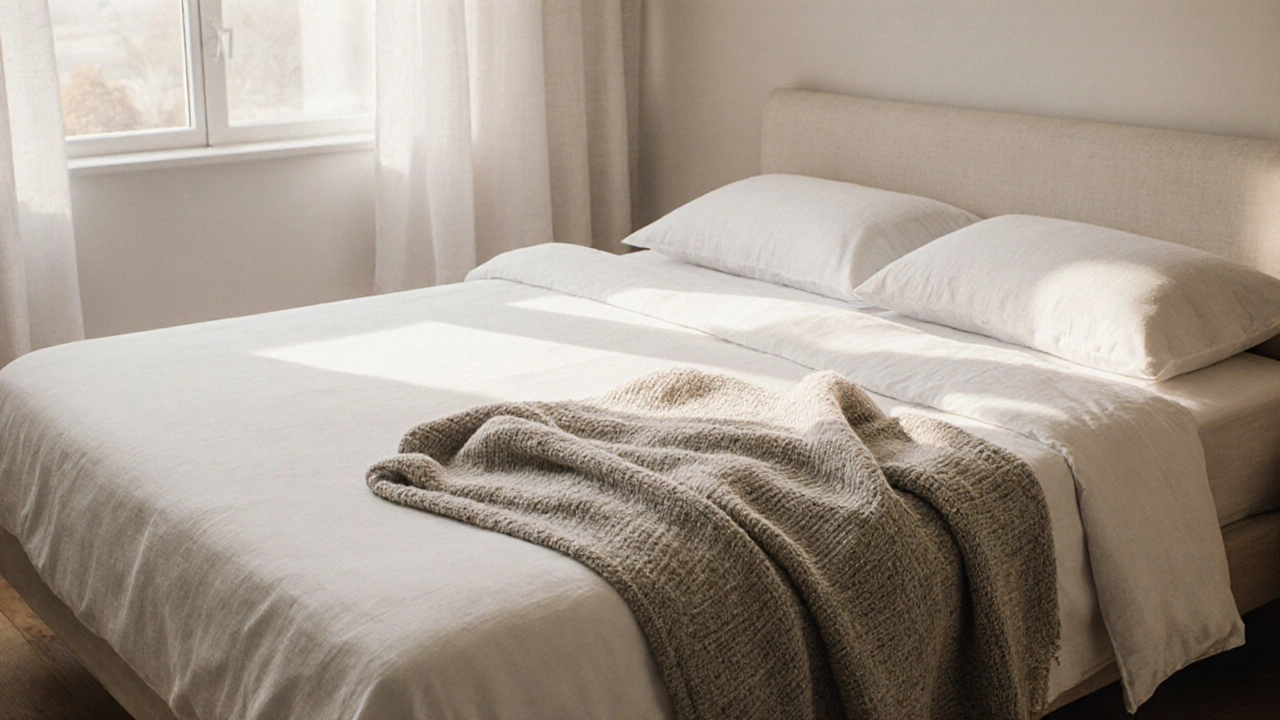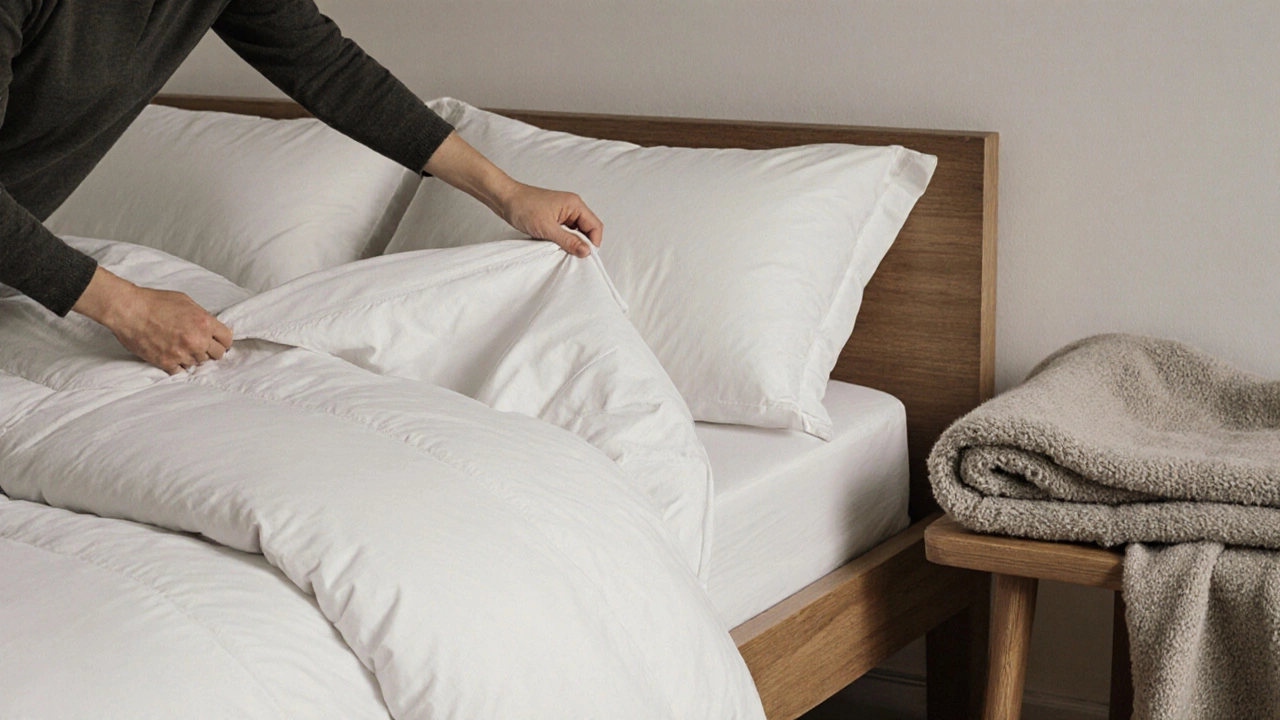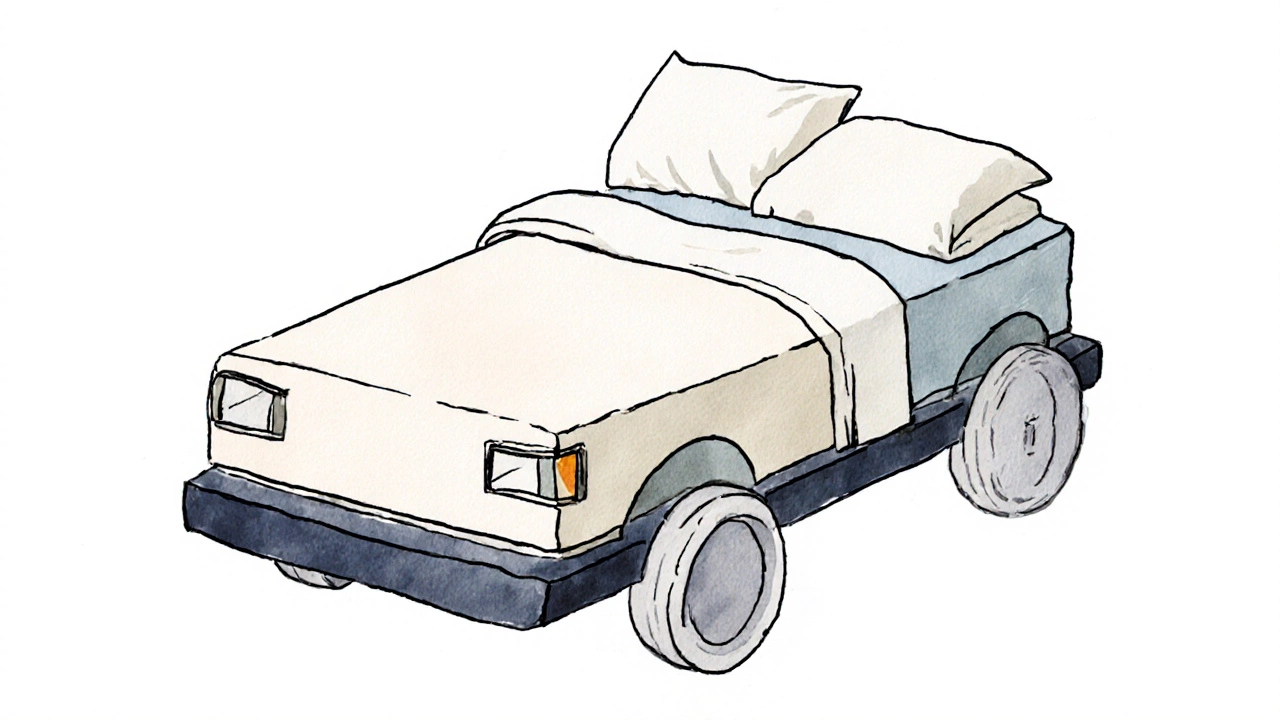Does Bedding Mean Blankets? Clearing Up the Confusion

Bedding System Checker
Check if you have the complete bedding system for a clean, comfortable night's sleep. Bedding is more than just blankets—it's the complete system that includes sheets, pillowcases, duvet covers, and more. Select what you have:
Your Bedding Items
Essential Bedding System
The Complete System (Required)
For a proper, hygienic bedding system, you need these components:
- ✅ Fitted sheet
- ✅ Flat sheet
- ✅ Pillowcases
- ✅ Duvet cover
Optional Layer (Not Required)
Blankets are just one optional layer that can be added for extra warmth:
- ❄️ Blanket (only add if needed)
Your Bedding System Status
When someone says "bedding," do you immediately picture a soft blanket draped over the bed? You’re not alone. But here’s the truth: bedding isn’t just blankets. It’s the whole system that makes your bed sleep-ready - and skipping that distinction can lead to bad shopping choices, mismatched sets, and frustrated mornings.
Think of your bed like a car. You wouldn’t say "the car means the steering wheel," right? The steering wheel is one part. Bedding is the same. Blankets are just one piece. The full set includes sheets, pillowcases, duvet covers, mattress pads, and yes - blankets. But calling all of that "blankets" is like calling a smartphone "the screen." It’s not wrong, but it’s incomplete.
What Actually Counts as Bedding?
Bedding refers to all the removable textile items you put on or around your mattress to sleep on. That includes:
- Flat sheets and fitted sheets
- Pillowcases
- Duvet covers or comforter covers
- Blankets (wool, cotton, fleece, or electric)
- Bed skirts (optional, for aesthetics)
- Mattress toppers or protectors
- Throw blankets (sometimes included, sometimes not)
Most people buy bedding as a set - a fitted sheet, a flat sheet, and two pillowcases. That’s the basic trio. Add a duvet cover and you’ve got a full layering system. Blankets? They’re often sold separately. You can sleep under a blanket alone, but if you’re missing your fitted sheet, your mattress is exposed. That’s not bedding - that’s just a blanket on a bare mattress.
Why the Confusion Exists
The mix-up comes from how we talk. In casual speech, people say things like, "I need new bedding for winter," and then grab a thick wool blanket. In stores, the blanket aisle is often right next to the sheet aisle, so it’s easy to assume they’re the same thing. Retailers even label some products as "bedding sets" that include only a blanket and a pillowcase - misleadingly suggesting that’s the whole package.
Historically, before duvets became popular, people used layered blankets and quilts directly on the bed. That’s where the idea of "bedding = blanket" stuck. In older homes in New Zealand, for example, you’d still find wool blankets tucked under a cotton sheet. But today’s standard bedding is built around a layered approach: sheet → duvet cover → blanket → top sheet. Each has a job.
Blankets Are Just One Layer - And Not Always the Main One
Here’s a real example: A couple in Wellington buys a new wool blanket for winter. They think they’ve got their bedding sorted. But they skip the fitted sheet. Come morning, the blanket slides off the mattress every time they turn over. They wake up cold and annoyed. Why? Because the blanket wasn’t anchored. The fitted sheet holds everything in place. The duvet cover keeps the insert clean and easy to wash. The blanket? It’s just the warm top layer.
In fact, many people in warmer climates - like Auckland or the North Island - sleep under just a cotton sheet and a light duvet. No blanket needed. Others in colder regions use two blankets: one under the duvet cover as a base layer, and one on top. The blanket isn’t the star. It’s the supporting actor.

What You Should Buy Instead of Just a Blanket
If you’re shopping for bedding, start with the essentials:
- Fitted sheet - This is non-negotiable. It holds the mattress in place and gives everything else a foundation.
- Flat sheet - Protects your duvet or blanket from skin oils and sweat.
- Pillowcases - You change these weekly. Don’t skip them.
- Duvet cover - Far easier to wash than a bulky comforter. Most modern bedding systems use this instead of a traditional top blanket.
- Blanket - Only add this if you need extra warmth. Choose it after the base layers are covered.
Buying a blanket alone? You’re missing 75% of what makes a bed comfortable and hygienic. You’re also risking skin irritation, dust mite buildup, and sheets that slip off all night.
How to Know If You’re Missing Bedding Pieces
Ask yourself these three questions:
- Is your mattress covered with something that stays put? If not, you need a fitted sheet.
- Do you wash your top layer weekly? If you’re washing a blanket every week, you’re doing it wrong. Duvet covers and sheets are meant for that. Blankets go in the wash every few months.
- Do you feel cold because your top layer is thin, or because there’s no barrier between you and the mattress? If it’s the latter, you’re missing a sheet.
Bedding is about function, not just warmth. It’s about hygiene, comfort, and ease. A blanket alone doesn’t deliver that.

What Experts Say
The Sleep Foundation, a U.S.-based research group that studies sleep health, defines bedding as "all textile items used on a bed for comfort and hygiene." Their guidelines list sheets, pillowcases, and covers as the core components. Blankets are listed under "optional accessories."
Similarly, New Zealand’s Consumer Protection Agency advises shoppers to check product descriptions carefully. Many online stores list "bedding sets" that include only a blanket and pillowcase - a red flag. Legitimate sets include at least a fitted sheet, flat sheet, and pillowcases.
Bottom Line: Blankets Are Part of Bedding - But Not All of It
So, does bedding mean blankets? No. Blankets are one piece of bedding - like a tire is one piece of a car. You need the whole system to work right. If you’re shopping for bedding, start with sheets and pillowcases. Add a duvet cover. Then, if you still feel chilly, pick a blanket that matches your climate and sleep style.
Don’t let the casual use of the word fool you. Bedding isn’t just warmth. It’s structure. It’s cleanliness. It’s the foundation of a good night’s sleep. And that’s more than just a blanket.
Is a blanket considered bedding?
Yes, a blanket is part of bedding, but it’s only one component. Bedding includes sheets, pillowcases, duvet covers, and mattress protectors. A blanket alone doesn’t make a complete bedding set.
What’s the difference between bedding and linens?
"Linens" usually refers to sheets and pillowcases - the fabric that touches your skin. "Bedding" is broader: it includes linens plus blankets, duvet covers, and mattress toppers. In everyday use, people often say "linens" when they mean bedding, but technically, linens are a subset.
Can I sleep without sheets if I have a blanket?
You can, but you shouldn’t. Without sheets, your blanket gets dirty faster from sweat and skin cells. It’s harder to wash, and you risk skin irritation and dust mites. Sheets act as a protective barrier. Skipping them saves time now but costs you in cleanliness later.
Do I need a duvet cover if I have a blanket?
If your blanket is washable and you don’t mind cleaning it often, you don’t need a duvet cover. But most blankets aren’t designed for weekly washing. A duvet cover protects your blanket, keeps it clean, and lets you change the look of your bed easily. It’s a smart upgrade, not a luxury.
What should I buy first if I’m setting up a new bed?
Start with a fitted sheet, flat sheet, and two pillowcases. These are the minimum for hygiene and comfort. Then add a duvet cover. Only after that should you consider a blanket, especially if you live in a mild climate. Blankets are the last layer - not the foundation.